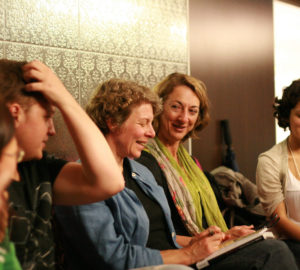
How to Stop Dreaming and Start Writing, One Word at a Time
Let me tell you something that might sting a little: talent is overrated. I know, I know. We all want to believe we’re undiscovered literary geniuses about to launch a bestseller. But here’s the truth that Nichola Meyer, Principal of The Writers’ College, has discovered after two decades of witnessing thousands of creative writers graduate from their courses: It’s not talent or word power that makes writers successful; it’s staying power.
Staying power. Not the ability to craft powerful sentences, but the stubborn refusal to quit when your mind is a complete vacuum and your inner critic won’t let you forget it.
So how do you cultivate this staying power? How do you transform from a dreamer who talks about writing novels into an actual novelist who’s typed ‘The End’? The answer may lie in something simple: SMART goals.
The writing magic of SMART goals
Before you roll your eyes and start muttering about corporate buzzwords infiltrating the realm of art, hear me out. SMART goals aren’t the enemy of creativity – they’re its practical partner who makes sure creativity actually shows up to work.
SMART goals are:
- Specific: Not ‘write a novel’ but ‘write an 80,000-word spec fic novel about a family of four surviving on post-apocalyptic Earth, floating on an island of debris’
- Measurable: You can count words, scenes and chapters: progress you can actually see
- Attainable: Realistic enough that you won’t burn out by Tuesday
- Relevant: Aligned with your actual writerly dreams, not someone else’s
- Time-bound: With deadlines that motivate rather than terrorise
Edwin Locke, the psychologist whose goal-setting research has been tested and supported by hundreds of studies involving thousands of participants, discovered something indisputable: in most empirical studies, having specific and challenging goals in place led to higher performance. That’s not just corporate speak. That’s science backing up what every working writer knows in their bones.
Know thyself: the writer’s speed assessment
Your goals need to match your writing speed, or you’re setting yourself up for what I like to call ‘the writing doldrums’ – that special kind of despair that comes from drifting aimlessly when you fail to meet your own expectations.
Here’s what you can realistically expect for a first draft:
Fast writers (bless their caffeinated hearts): 3–6 months, cranking out 1,000–2,000 words daily. These are the sprinters of the writing world, the ones who make the rest of us feel like we’re typing with mittens on.
Average pace writers: 6–12 months for that glorious, messy first draft of 70,000–100,000 words. This is where most of us mortals live.
Slow but steady writers: 1–2 years for a first draft. Maybe you’re juggling a day job that actually pays the bills, or you’re writing historical fiction that requires you to research 18th-century farming techniques. Whatever the reason, consistency and thoroughness pay off.
From idea to finished manuscript? Most traditionally published novelists take one to three years. That includes outlining, writing, crying, revising, getting feedback, more crying, and doing multiple rounds of edits. Historical fiction writers and world-builders tend toward the longer end. Romance and thriller writers with established formulae can be speed demons, sometimes publishing two books per year.
The key is to be honest – brutally honest – about your actual writing speed, not your fantasy writing life.

The tiny steps revolution
James Clear, author of the best-selling Atomic Habits, offers wisdom that’s pure gold for novelists. His book reveals practical strategies that will teach you exactly how to form good habits, break bad ones and master the tiny behaviours that lead to completed manuscripts.
Dream big, absolutely. But start with what Clear calls ‘atomic habits’ – tiny, sustainable actions that compound over time. Meyer’s rule of thumb is brilliant: 200 words per working day adds up to 1,000 by Friday. That’s infinitely better than the Monday Miracle approach: writing 1,000 words in a burst of inspiration and then never touching your manuscript again.
This isn’t just feel-good advice. It’s rooted in how our brains actually work. When we try to make massive changes – like going from zero words to 2,000 words daily – we trigger what psychologists call ‘psychological reactance’. Our brains literally fight back against the change. But 200 words? That’s about a paragraph. Your brain barely notices.
Write small. Build momentum. Adapt weekly if you’re falling behind or raise the bar modestly if you’re sprinting ahead. The goal isn’t to be a writing superhero; it’s to be a writing human who actually finishes things.
Breaking your novel down into tiny steps
Don’t write a novel all at once. This seems obvious, but you’d be amazed at how many writers treat their novels like they’re some kind of literary Mount Everest to be conquered in a single, heroic effort.
Instead, break your massive, terrifying goal into mini milestones that don’t make you want to hide under your desk:
- Week 1: Outline your story’s revolution – setting, characters, back stories, what’s at stake
- Weeks 2–4: Write Chapter 1 (or your first 2,000 words)
- Months 2–3: Write Chapter 5
- And so on, until you’ve tricked yourself into writing an entire novel
Cat Rambo, previous President of the Science Fiction and Fantasy Writers of America (SFWA), suggests mapping out your milestones – outline, first draft, polished draft, beta-ready manuscript – and scheduling them realistically over months or years, not weeks. This isn’t about speed; it’s about your writing schedule being sustainable.
Routines: the creativity whisperers
Let’s talk about routines, shall we? I know that routines sound about as exciting as watching paint dry. But here’s the thing: routines don’t stifle creativity; they seduce it out of hiding.
Meyer has seen it over and over: ‘We’ve seen super-talented writers fizzle out halfway through the course solely because they couldn’t stick to their routine. Meanwhile, less naturally gifted writers with solid routines finish their novels and go on to publish them.’
James Clear argues that goals can provide direction and even push you forward in the short-term, but eventually a well-designed system will always win. Goals get you started; systems keep you going.
So set yourself writing hours – even just 30 minutes – and make them sacred. Whether you write best in a bustling coffee shop or in monastic silence, honour your creative needs. Your creativity is like a dog: it needs to know when and where it can expect to be fed.
Successful authors lean on routines because imagination thrives on ritual. As Bonnie Friedman wisely observed: ‘Successful writers are not the ones who write the best sentences. They are the ones who keep writing.’
The bad days (and why they’re your friends)
Norman Mailer once said, ‘Being a real writer means being able to do the work on a bad day.’ You will have rotten days – days when your words feel dead and Netflix seems infinitely more compelling than your plot twist.
That’s okay. Expected, even. Write anyway, even if it’s just for five minutes. Even if what you produce is garbage. The work isn’t in writing brilliantly; the work is in showing up.
Julia Cameron, author of The Artist’s Way, puts it perfectly: what defines a writer is ‘showing up at the page, no matter what.’ This includes showing up when you feel like a fraud, when your day job sucked the soul out of you, or when you’re pretty sure your novel is the literary equivalent of a grocery list.
When doubt knocks (and it will)
Self-doubt isn’t a bug in the writing system; it’s a feature. Expect it. Prepare for it. Respond with a plan:
- Walk away for an hour (fresh air is magic)
- Re-read that encouraging comment from your writing group
- Send your draft to a trusted writing friend
- Remind yourself that doubt is just fear wearing a fancy disguise
Your goal isn’t just to write – it’s to manage your writing self.
The SMART goal in action
Here’s what your final SMART goal might look like, dressed up and ready for action:
‘I will write a first draft of an 80,000-word spec fic novel about a family of four surviving on post-apocalyptic Earth, floating on an island of debris, by writing 350 words per working day between 8 and 9 p.m., five days a week, and finish the first draft in 365 days.’
Look at that beauty. Specific enough to mean something, measurable enough to track, attainable enough to not break you, relevant to your dreams, and time-bound enough to create gentle urgency.
This isn’t goal-setting – it’s goal-befriending. You’re creating a gentle companion for the journey ahead.
The infinitely valuable writing tribe
Finally, writing can be lonely, but it doesn’t have to stay that way. Find your people: online circles, Facebook groups, local writing meetups or even just one fellow writer who understands the madness of choosing to make up stories for a living.
Accountability is a lifeline. It transforms your writing commitment from a vague promise to yourself into a living pact with others who are walking the same path.
Writing a novel isn’t a single heroic leap. It’s a series of tiny, brave steps. It’s not about having more talent than the next person; it’s about keeping going. It’s about setting SMART goals, building sustainable habits, and showing up to the page even when – especially when – the words don’t flow.
Build habits that serve you. Write often, even when it’s awful. Move forward and keep going. Because here’s the secret that every published novelist knows: the only way to write a truly bad novel is not to finish it. The only way to write a good novel is to finish it and then refine it.














